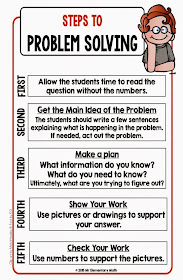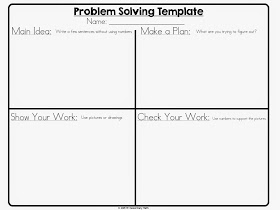Have you ever given your students a money word problem where someone buys an item from a store, but your students come up with an answer where the person that bought the item ends up with more money than he or she came in with? Word problem solving is one of those things that many of our children struggle with. When used effectively, questioning and dramatization can be powerful tools for our students to use when solving word problems. I recently co-taught a lesson with a 3rd teacher who was having difficulty with getting her students to comprehend a word problem she presented.
We came up with a lesson that actually helped students to better understand problem solving. The approach we took included the use of several literacy skills, including reading comprehension and writing. We started the lesson with a "think aloud" modeled by the teacher.
We read and displayed the problem below but excluded ALL of the numbers. See the images below.
The purpose of reading the problem without the numbers is to get the students to understand what is actually happening in the problem. Typically some students focus solely on keywords when solving word problems, but I do not advise using this approach. With math problems, the context of the problem and actions in the problem determine how the child should go about solving it.
1st - Read the Problem & Ask Questions:
After reading the problem (without numbers) to the students, I asked the following questions:
- Can you describe what is happening in your own words?
- What is the main idea of the problem?
- How could you act this out?
2nd - Make a Plan & Ask Questions:
After the students articulated what was happening in the problem, we made a plan to solve the problem. I used the following guiding questions:
After the students articulated what was happening in the problem, we made a plan to solve the problem. I used the following guiding questions:
- What information do we know?
- Sample Answers include- We know that Kai has some goldfish. Kai donated or gave away some of the goldfish.
- What information do we need?
- Sample Answers include- We need to know how many goldfish Kai has. We also need to know how many he gave anyway. We also need to know how many bowls there are.
- Ultimately, what are we trying to find out? (What is the question wanting you to find?)
- Sample Answers include- We need to find out how many fish belong in each bowl.
The class discussed the answers to the questions above. As we discussed the questions above the responses were written out on a problem solving template similar to the one below.
As part of this process, we clarified student understanding of the problem and determined what we needed to find and do to solve the problem. Next, we walked the students through the process of showing their work using pictures. Lastly we checked our answers by writing an equation that matched the pictures to finally solve the problem.
Team Work Counts
After going through the process with the class, we decided to split the students into small groups of 3 and 4 to solve a math problem together. The groups were expected to use the same process that we used to solve the problem. It took a while but check out some of the final products below.
Some of the benefits to using this process include:
- The students understood what the problem is asking them to do.
- The students are required to think and communicate as a team.
- The students avoid making errors that can come with only using key words.
- The students are required to record their math reasoning using the problem solving template.
- After using this process a couple of times, the students get used to explaining and justifying their answers.
- The teacher becomes the facilitator of the learning by asking more questions, thereby making students independent thinkers
Some of things to consider when using this process include:
- This process in NOT quick. It requires TIME. You should not rush the process and expect to have it completed in 20 - 30 minutes in one day.
- This process is not a one time lesson. Students may not get it the first time. It should be seen a routine that can be used when solving word problems.
If students are still having problems, I would strongly recommend having students quickly act some of these problems out. Sometimes students are so focused on the numbers, they only want to add/subtract/multiply/divide but have no clue what is happening in the problem.
Before I wrap up this post, let's review the steps when using this process for problem solving.

Be sure to let me know how this process works in your classroom!








This is great! My kiddos have really struggled with solving word problems and choosing the correct operation. We've been working on acting it out and drawing a picture so they can see what is actually happening. Thanks for sharing these tips and ideas!
ReplyDeleteBrandi
Swinging for Success
Thanks Brandi. Word problems can be pretty tough for students. Perseverance is definitely required from us as educators. This process is not something that is easy but it is necessary to move our students to the next level. I really appreciate your comments.
DeleteI like the way you suggest breaking down a problem. Really comprehending the problem instead of just circling keywords is critical.
ReplyDeleteThanks Adam for your positive comments. In my belief comprehending and deep understanding should always be our start and finish point. I'm not a big fan of circling keywords because I've seen it as a misleading strategy for our students. True understanding is at the heart of what we do. Thanks again.
DeleteI loved your post about the math problem solving. I just started my Masters in Math and Literacy and was researching ways to improve problem solving in students with disabilities. The process that you shared echoes the research, which suggests to use reading strategies, such as visualizing, restating, and retelling, to have students comprehend the problem. I am in complete agreement with you on the over-reliance students have on key words. In the absence of a key word or with implied key words, they are left without a strategy or plan to follow. Just this week, I started implementing the reading strategies in math, along with drawing pictures of their visualizations. I am eager to see how the kids will do with this over time. You are right. It takes a while, but my co-teacher and I have allotted at least 30 minutes a day to problem solving. I think it is going to definitely be time well spent. Thanks for sharing your templates.
ReplyDeleteVaseem Mohammed
Vaseem, I just saw your comment. I don't know how I missed this one. Your welcome. My wife is a literacy coach and we often talk about the connections between reading and math. We have to be very careful about using key word strategies because they an cause misconceptions that will be hard to undo later. I am also a fan of having students act out problems, especially in the younger grades. A lot of times students are not focused on what is happening in the problem or the problem is asking them to do. We need to take the extra time to see if students comprehend what is happening in the problem first before solving. If we don't take the time, students just start adding, subtraction, multiplying or dividing without any thought. These same students will really have a difficult time when they get to multi-step word problems.
DeleteGreg
Great information! Sharing with my Facebook followers : )
ReplyDeletehttps://www.facebook.com/theclassroomkey
Love this! My students go straight to those numbers so they can start solving right away. I love how eliminating those numbers brings focus to the process of what is happening! ����
ReplyDeleteThanks! I see a lot of this, kids going straight to the numbers and not taking the time to comprehend the problem. Thanks for commenting : )
DeleteGreg.......When the students went into their groups what type of word problems did you give them? One step? two step? BTW....love this!
ReplyDeleteThanks for your comment Vicki. I used one step problems. I have never done this activity with a 2 step problem, but I think that if you do the same procedure for each step, it will work just as well. I would do it in chunks.
DeleteGreg